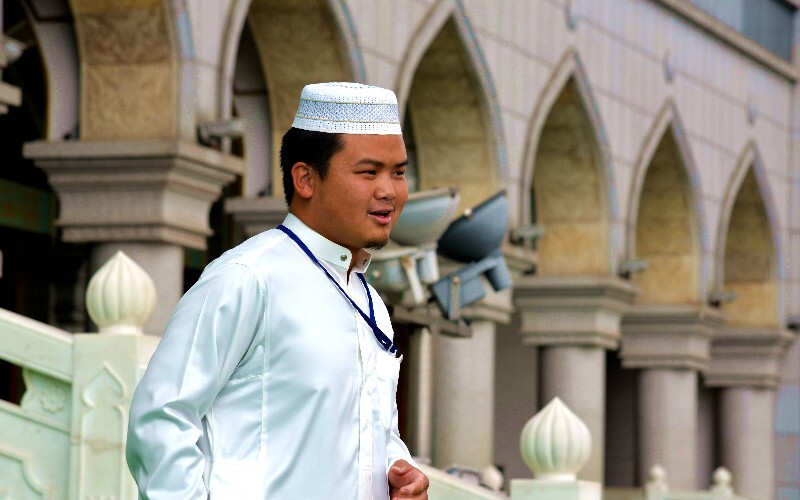Today, there are about 25 million Muslims spread across China, scattered widely and concentrated in small groups. Islam is one of the four or five officially recognised religions in China.
The Spread of Islam
 Idgar Mosque in Kashgar, Xinjiang, shows Islamic architecture.
Idgar Mosque in Kashgar, Xinjiang, shows Islamic architecture.Thefirst major Muslim settlements in Chinaconsisted of Arab and Persian merchants. Islam penetrated China's interior during the Tang and Song dynasties, mainly along thesilk routewhen there were frequent friendly exchanges between governments and many envoys came to do business.
There weretwo silk trade routes、陆路和海上路线。这些贸易路线were a very important connection that formed the bridge that allowed Chinese culture to be introduced to the West and at the same time, transmitted the philosophical concepts of Islam and the West to China.
Muslim expansion continued during the subsequent dynasties. In addition to the new faith and culture that the Muslims introduced, they made substantial contributions in the field of medicine and also helped the rulers in defending the country at various times.
For more, seeIslam in China.
Muslim Majority Provinces
Muslims live in all parts of China but the greatest numbers are found in the provinces ofXinjiang,Gansu,QinghaiandYunnan. The Xinjiang region has the largest Muslim population in China. About 50% of the people there are Muslim.
The provinces with the highest concenteration of Muslims in China are Xinjiang Uygur Autonomous Region, Ningxia Hui Autonomous Region, Qinghai Province, Gansu Province, Yunnan Province, Tianjin Municipality, BeijingMunicipality, Henan Province, Inner Mongolia Autonomous Region, and Hebei Province.
Muslim Ethnic Groups
TheHui人最大的穆斯林在中国,followed by theUyghurs. The Hui and the Uygur ethnic groups make up about 90% of the total Muslim population in China.
Of the 55 officially recognised groups of ethnic minorities, 10 are predominantly Muslim. They make up about 20% of the total ethnic minorities in China.
TheMuslim ethnic groupsinclude the Hui (48% of the officially tabulated Muslim population), Uygur (41%), Kazakh (6,1%), Dongxiang (2.5%), followed by the Kyrgyz, Uzbeks, Salar, Tajik, Bonan and Tatar groups.
Mosques in China
 Niujie Mosque in Beijing shows traditional Chinese architecture.
Niujie Mosque in Beijing shows traditional Chinese architecture.The mosque ormasjidis the Islamic place of worship where Muslims say there prayers. It can also serve as a centre for information, education, social welfare and some other community affairs.
Mosques in Chinaappeared in the Tang Dynasty and the Huaisheng Mosque in Guangzhou, Qingjing Mosque in Quanzhou, Zhenjiao Mosque in Hangzhou, and Libai Mosque in Yangzhou werethe oldest four mosques in China.
Mosques have unique designs following a distinctive Islamic architectural style. Characteristic features include aminaretwhich is a tower-like structure from where the call to prayer orAzanis made, one or moredomeswhich may signify the vault of heaven, a semicircularnichein one wall indicating the direction to be faced when praying, and aprayer hallwhere the worshippers say there prayers.
Some mosques in China are built on the Islamic architectural design while others have some elements of traditional Chinese architecture.
Today, there are more than 39,000 mosques in China.
Halal Food
Halal food在中国是可用的。清真是阿拉伯语word which means permissible or lawful. In Chinese, halal food is called Qing Zhen Cai (清真菜) which literally translates to "pure food".
The most common Chinese Muslim restaurant is the Lanzhoulamian('Lanzhou pulled-noodles' 兰州拉面) kind, which can be easily found in almost every city. In addition to Chinese halal cuisine, there are Turkish restaurants in many cities that serve a wide variety of halal dishes.
Muslim restaurants can be expected to be closed during Ramadan.
Muslim Holidays
There are two main festivals in Islam,Eid-ul-FitrandEid-ul-Adha.
Eid-ul Fitris celebrated at the end of the Islamic holy month of Ramadan when Muslims fast for the whole month. They refrain from eating and drinking from dawn till sunset everyday and are expected to spend as much time as possible in supplication. At the end of the month, Eid-al- Fitr is observed.
Eid-ul-Azhais celebrated in commemoration of the great spirit of sacrifice of prophet Abraham. Sacrificial animals are slaughtered and the meat is divided into three parts, one part to be distributed among the poor, one part to be sent to relatives and friends and one part to be used at home.
During both festivals, the day starts with a specialEidprayer offered at the mosque or open place and then special meals are cooked, families gather together, celebrate and have a good time.
In addition to the two main festivals, some other days are also celebrated and have historic and religious significance.Ramadanis a holy month and all Muslims fast during this time.Mawlid-un-Nabiis the birthday of the prophet Muhammad and is celebrated in most sects though this celebration is regarded as an innovation in some.Ashurais a solemn day that marks the martyrdom of the grandson of the prophet Muhammad.
Some of the important days in the Islamic calendar with dates are given below. As the Muslim calendar follows the lunar system, it is different from the Gregorian calendar and dates keep changing every year. As such, the dates given are not exact and are only approximate.
| Holiday | Islamic Date | 2018 | 2019 | 2020 |
|---|---|---|---|---|
| Islamic New Year | 1 Muharram | 11 September | 31 August | 20 August |
| Ashura | 10 Muharram | 20 September | 9 September | 29 August |
| Mawlid-an-Nabi | 12 Rabi al- Awwal (Sunni sects) | 20 November | 9 November | 29 October |
| Mawlid-un-Nabi | 17 Rabi al Awwal (Shia sects) | 25 November | 14 November | 3 November |
| First day of Ramadan | 1 Ramadan | 16 May | 6 May | 24 April |
| Eid-ul Fitr | 1 Shawwal | 15 June | 4 June | 24 May |
| Eid-ul Azha | 10 Dhul- Hijja | 21 August | 11 August | 31 July |
Explore Muslim Culture in China with Our Bespoke Services
Exploring the Muslim world in China by retracing the silk route will give an exciting incite into a unique culture along with the mainstream Chinese culture.
Tour along the great Silk Roadand scan the breadth of China from West to East witnessing historic cities with large Muslim populations, marvellous landscapes and extraordinary cultures along the way, or select ourCreate My Trip Servicefor a free personalised itinerary suggestion and quote, including accommodation.









